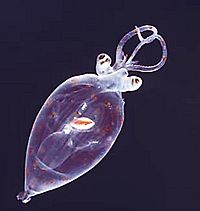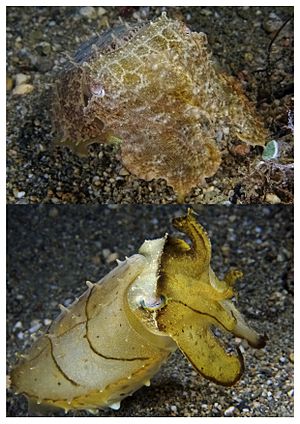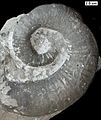Cephalopod facts for kids
Quick facts for kids Cephalopods |
|
|---|---|
 |
|
| Juvenile squid from plankton Antarctica |
|
| Scientific classification | |
| Kingdom: | |
| Phylum: | |
| Class: |
Cephalopoda
|
| Subclass | |
|
Subclass Nautiloidea |
|
Cephalopods are amazing sea animals. Their name comes from Greek words meaning "head-foot." This is because their arms or tentacles grow right from their heads! They are a special group of molluscs, like snails and clams. Cephalopods have bodies that are the same on both sides (this is called bilateral symmetry). Scientists who study cephalopods are called teuthologists.
Today, there are two main groups of living cephalopods. One group, called Coleoidea, includes the octopus, squid, and cuttlefish. These animals usually have a very small shell inside their body, or no shell at all. The other group, called Nautiloidea, still has a large outer shell. The only living animal in this group is the Nautilus.
There are at least 800 different kinds of living cephalopods. Many more kinds are now extinct, like the Ammonites and Belemnites. You can find cephalopods in all the world's oceans. They live at all depths, from the surface to the deep sea. None of them can live in freshwater. However, a few species can live in brackish water, which is a mix of fresh and salt water.
Contents
What are the Main Cephalopod Groups?
Cephalopods can be divided into several groups. Some of these groups are still alive today, while others are only known from fossils.
- Nautiloids: These are the oldest group. The Nautilus is the only living example.
- Ammonoids: These are Ammonites, which are now extinct. They had coiled shells.
- Coleoids: This is the largest group today.
- Belemnites: These are extinct, squid-like animals.
- Squid: There are four different groups of squid.
- Cuttlefish: These are often called Sepia.
- Octopus: These are known for having eight arms.
How Many Cephalopod Species Are There?
Scientists are still discovering new types of cephalopods! The number of known species keeps growing.
- In 1998, there were 703 known living species.
- By 2001, this number grew to 786.
- By 2004, experts thought there might be between 1,000 and 1,200 species.
There are many more fossil species than living ones. Scientists believe there are about 11,000 extinct types of cephalopods.
How Smart Are Cephalopods?
Cephalopods are some of the smartest invertebrates (animals without backbones). They have excellent senses and very large brains. Their nervous system is the most complex of any invertebrate. Their brain size compared to their body size is similar to that of warm-blooded animals. Scientists often study the large nerves in a cephalopod's mantle because they are big and easy to examine.
How Do Cephalopods Change Colour?
Most cephalopods have special cells called chromatophores. These cells contain different colours. Cephalopods can use them in amazing ways. They can change their colour very quickly to blend in with their surroundings. Some cephalopods can even make their own light, a process called bioluminescence. They shine light downwards to hide their shadows from predators below.
This light is made by tiny bacteria that live inside the cephalopod. The cephalopod can control the light these bacteria make. Bioluminescence can also be used to attract prey. Some species use colourful light shows to find mates, scare away predators, or even talk to each other.
How Fast Can They Change Colour?
Cephalopods can change their colour in just milliseconds (tiny fractions of a second). They do this by making their pigment cells expand or shrink. Fast colour changes are more common in cephalopods that live near the shore. Those in the open ocean often use camouflage to make their body outline hard to see.
Scientists have found signs of colour patterns in cephalopod fossils from long ago. Some ancient shelled species had lines on their shells. These lines might have helped them hide their body shape. Even older cephalopods had more complex colour patterns, which might have had different uses.
How Do Cephalopods Move?
Cephalopods usually move by jet propulsion. This means they squirt water out to push themselves forward. This way of moving uses a lot of energy compared to how fish swim with their tails. Cephalopods use jet propulsion because they do not have fins or flippers like fish. Larger cephalopods find jet propulsion less efficient. This is why many species use their fins or arms to move if they can.
They suck oxygen-rich water into a space called the mantle cavity, where their gills are. Then, they squeeze their mantle muscles to push the water out through a tube called a siphon. Usually, this pushes them backward as water shoots forward. However, the siphon can be pointed in different directions to change their movement. Some cephalopods can also change their body shape to glide through the water more easily.
Some octopus species can also walk along the sea bed. Squids and cuttlefish can move short distances in any direction. They do this by wiggling a flap of muscle around their mantle.
Do Cephalopods Use Ink?
Most cephalopods have an ink sac. The only exceptions are the Nautilidae and a group of octopuses called Cirrina. When a cephalopod feels threatened, it can squirt out a cloud of dark ink. This ink cloud helps to confuse predators, giving the cephalopod time to escape.
What Colour is Cephalopod Blood?
Like most molluscs, cephalopods use a special protein called haemocyanin to carry oxygen in their blood. This protein contains copper. Because of this, their blood is colourless when it doesn't have oxygen. But when it touches air, it turns blue! This is different from humans, whose blood uses haemoglobin and is red.
How Do Cephalopods Reproduce?
Most Coleoideans (like octopuses and squids) live short lives and grow very quickly. They use most of their energy to grow. Female Coleoideans usually lay many small eggs in one batch. After laying their eggs, they often die.
Nautiloids, on the other hand, live much longer. They lay only a few large eggs at a time, but they do this over many years.
How Did Cephalopods Evolve?
Cephalopods first appeared during the late Cambrian period. For a long time, they were the most common and diverse sea creatures during the Palaeozoic and Mesozoic eras. Tommotia, an early cephalopod, had tentacles like a squid. But it also had a snail-like foot that it used to crawl on the sea floor. Early cephalopods were at the top of the food chain.
The ancient and modern coleoids, as well as the ammonoids, all evolved from the shelled nautiloids. This happened between 450 and 300 million years ago. Most ancient cephalopods had protective shells on the outside of their bodies. These shells were first cone-shaped, but later they became curved, like the shells of modern nautilus species. Many living cephalopods, like cuttlefish, still have shells, but they are inside their bodies. The most famous group with outer shells, the ammonites, died out at the end of the Cretaceous period.
Images for kids
-
The primitive nautilus eye works like a pinhole camera.
-
The two-part beak of the giant squid, Architeuthis sp.
-
Amphioctopus marginatus eating a crab.
-
Female Argonauta argo with eggcase and eggs.
-
Chtenopteryx sicula paralarvae. Left: Two very young paralarvae. Centre: Views of a more advanced paralarva. Right: Views of a very advanced paralarva.
-
An ammonoid fossil showing its wavy patterns.
-
Chambered nautilus (Nautilus pompilius).
-
Common cuttlefish (Sepia officinalis).
-
Common octopus (Octopus vulgaris).
-
Various species of ammonites.
-
A fossilised belemnite.
See also
 In Spanish: Cefalópodos para niños
In Spanish: Cefalópodos para niños





















